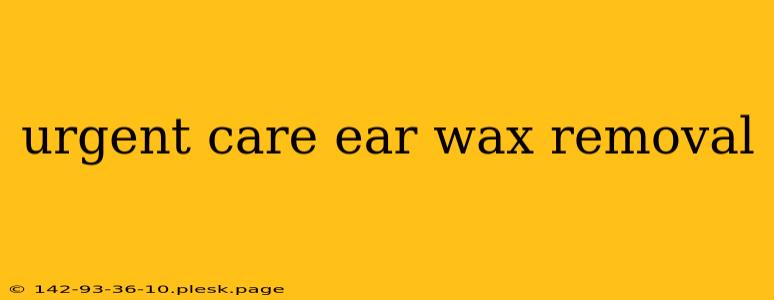Earwax, or cerumen, is a naturally occurring substance that protects your ear canal. However, excessive buildup can lead to discomfort, hearing loss, and even infection. While many cases of impacted earwax can be managed at home, some situations require urgent care ear wax removal. This post will outline when you should seek immediate medical attention for earwax buildup and what to expect during the procedure.
Understanding the Symptoms of Impacted Earwax
Before delving into when urgent care is necessary, let's understand the symptoms of impacted earwax. These can range from mild to severe:
- Hearing loss: A common symptom, often described as muffled sounds or a feeling of fullness in the ear.
- Earache: Pain in the ear, which can range from mild discomfort to severe throbbing.
- Itching: An irritating itch inside the ear canal.
- Tinnitus: A ringing, buzzing, or hissing sound in the ear.
- Cough: In some cases, impacted earwax can trigger a persistent cough.
- Dizziness or vertigo: While less common, severe earwax buildup can sometimes cause dizziness or a feeling of spinning.
- Ear drainage: Pus or other drainage from the ear, often indicative of infection.
When Urgent Care is Necessary for Earwax Removal
While many people successfully manage minor earwax buildup at home with over-the-counter solutions, there are situations demanding urgent care:
- Severe pain: Intense ear pain that doesn't respond to home remedies warrants immediate medical attention.
- Sudden hearing loss: A sudden, significant decrease in hearing ability requires prompt evaluation and treatment.
- Infection: If you suspect an ear infection (indicated by pus, severe pain, fever), seek urgent care immediately. Delaying treatment can lead to complications.
- Bleeding: Bleeding from the ear canal necessitates immediate medical attention.
- Feeling of fullness and pressure accompanied by dizziness or vertigo: This combination of symptoms should be evaluated by a medical professional.
- Underlying medical conditions: Individuals with diabetes, weakened immune systems, or other conditions may be at higher risk of complications from earwax buildup and should seek medical advice sooner.
What to Expect at Urgent Care
When you visit urgent care for earwax removal, a medical professional will likely perform the following:
- Examination: They will examine your ear canal using an otoscope to assess the extent of the wax buildup.
- Removal techniques: Several methods might be used to remove the earwax, including:
- Irrigation: A gentle stream of warm water is used to flush out the wax.
- Curettage: A small, specialized instrument is used to carefully remove the wax.
- Suction: A suction device might be employed to remove stubborn wax.
The chosen method will depend on the severity of the buildup and the individual's situation.
Preventing Future Earwax Buildup
While occasional professional earwax removal might be necessary, you can take steps to prevent excessive buildup:
- Avoid using cotton swabs: These can push wax further into the ear canal, causing impaction.
- Use ear drops (as directed by a doctor): Certain ear drops can help soften and remove earwax.
- Regular cleaning (when necessary): Gently wipe the outer ear with a soft cloth.
Disclaimer: This information is for general knowledge and does not constitute medical advice. Always consult with a healthcare professional for any concerns regarding your ear health. They can properly diagnose and treat any ear-related issues.

